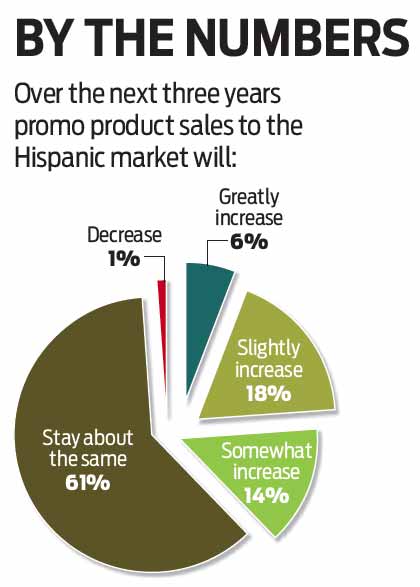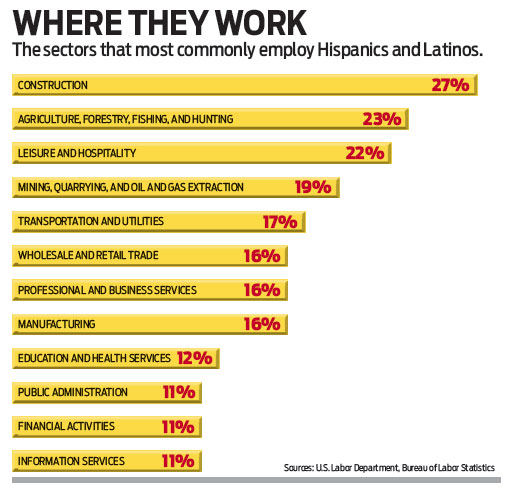September 29, 2016
Sell Promotional Products to the Hispanic Market
A primer on how to sell promotional products to one of the fastest-growing consumer segments in the United States.
A window into Hispanic and Latino experiences, culture and nuances – a sector mostly ignored by promo companies.
In the 1980 presidential election, Ronald Reagan won 56% of white voters, capturing a landslide victory of 44 states. If Reagan were running today and produced those same voter numbers, he’d very likely win only 24 states. How is this possible?
The simple answer is the demographics in the U.S. have dramatically shifted, with Hispanics and Latinos now making up a considerably larger portion – 17%, in fact – of the population. The number of Hispanic-Americans has boomed in the last three decades, increasing from 14.5 million in 1980 to 55 million today.
>>How To Sell to Unfamiliar Groups
The effects of this shift, of course, stretch immeasurably further than politics, especially into the business world. Hispanics’ collective consumer buying power in the U.S. was a staggering $1.3 trillion in 2015 – more than the annual GDP of nations like Spain, Australia, Russia and Mexico. There are also more than four million Hispanic-owned businesses in the U.S., generating combined yearly revenues of $660 billion, according to government and private-sector data. Clearly, on many levels, Hispanics and Latinos are a burgeoning force in our society.
And yet, to this point, many in the ad specialty industry have failed to take notice – or at the very least have failed to capitalize on the tremendous potential Hispanics offer. A new ASI survey shows only 4% of distributors currently have reps focused on selling specifically to the Hispanic market. Among firms that do actively target Hispanics for business, just 9% of their total promo product sales are to Hispanic/Latino clients.
Isn’t it about time for these numbers to change? With Hispanic Heritage Month upon us, this is the perfect moment to get to know the customer you’ve been missing out on all along.

>>More Promo Products Stats for the Hispanic Market
An Identity Crisis
Cindy Y. Rodriguez, a former CNN editor, asked a surprisingly contentious question in an article a few years ago. She wondered: “Which is it, Hispanic or Latino?” Her question was met with a huge range of responses. The reason? While there are technically set definitions for these two words, what they actually mean and what they connote are two separate things.
“If there’s one thing everyone should know about Hispanics in the United States, it’s that this rapidly growing minority has an undefined identity crisis,” says Rodriguez. “Why? Because of the confusion surrounding what to call people whose ethnic background is from Latin American and Spanish-speaking countries. Some even feel American or 100% Latino – or Hispanic, depending to whom you’re talking.”
InterExchange, a nonprofit organization that promotes cross-cultural awareness through work and exchange programs, defines Hispanics as “people from Spain or any other country that is Spanish-speaking in Latin America.” The term Latino, meanwhile, “has more varied definitions that generally include people from Latin America.”
Yet, as Rodriguez points out, in many parts of the U.S., Hispanics and Latinos may prefer to identify with their country of origin or their family’s country of origin. That means someone who is Latino but has parents from Chile may prefer Chilean-American over Hispanic or Latino. Case in point: In the Washington, D.C., area, many Salvadorans and Salvadoran-Americans have a strong allegiance to their home or heritage country, El Salvador. This is where complexities arise. A woman born in El Salvador, who has lived more than half her life in the U.S., could well see herself as American first, Salvadoran second, and prefer Hispanic over Latino.
Putting aside the counting conundrums spurred by illegal immigration, it’s entirely possible, then, that there are many more Hispanics and Latinos in the U.S. than even the census shows.
Similarities & Differences
While Hispanics and Latinos hail from diverse social, economic and geographic backgrounds, certain cultural similarities unite them. These include the Spanish language (though it’s not the only language among Latinos), religion (particularly Catholicism but certain Protestant denominations, as well) and family (with large, tight-knit units and relatively traditional gender roles). Still, there are nuances to know.
“The biggest mistake that companies and individuals make is to think that every Hispanic or Latino speaks Spanish,” says Christina Olivarez, advertising director of San Antonio Magazine. “Some salespeople think they know the general demographics of the market and don’t delve into the details.”
That’s why it’s important not to generalize. In reality, there are many different ways to be Hispanic or Latino and there are many Hispanic and Latino cultures – plural. So what key important variations should you know about?
The first is language. A Hispanic or Latino person may speak Spanish exclusively, English exclusively, be dominant in one language but conversational in another, or be fully bilingual. Meanwhile, some Latinos don’t speak Spanish at all because it’s not part of their cultural heritage. Brazilians speak Portuguese and Belizeans speak Belize Kriol English. Then there’s the matter of indigenous languages in Spanish-speaking countries. There are still hundreds of indigenous languages spoken in Central and South America. While many indigenous people from Latin America also speak Spanish, it’s important to remember that it’s likely their secondary language. That would make English their third language.
How can you address this as a salesperson? If you’re a small-business owner or part of a smaller sales team, you may not have the time or resources to communicate with someone in their native language or delegate this task. But what you can do, with no formal education or training, is adjust your word choice and up your patience. When speaking with Hispanics – at community gatherings, business meetings or networking events – be clear, not condescending, and know that you may have to repeat yourself, explain certain words or phrases, or use simpler vocabulary. Never make assumptions. Many Hispanics and Latinos are especially careful to watch your body language and a warm smile can make up for some communication challenges.
Another key difference to note: nationality and acculturation levels. The culture in Spain is not the same as the culture in Mexico. Some Hispanic and Latino cultures are more reserved, while others are more forthcoming. Find out where your customers are from and learn some cultural basics. How you relate to a Latino millennial who was born and raised in the U.S. and is English-dominant probably won’t be the same as how you relate to a Latino baby boomer who was born and raised in Mexico and is Spanish-dominant. “Do the qualitative research on each generation and see how it relates to that company or product,” says Olivarez.
If you speak Spanish, you’ll want to learn certain regional words (like mande and che) that may come up in conversation with a particular customer’s demographic. Even if you don’t speak Spanish, it helps to know if and when you should shake someone’s hand, kiss someone on the cheek, make ample or limited eye contact, or proceed with other gestures and courtesies. Again, body language matters because it forms a basis of trust and mutual understanding. You want to show that you’re receptive to your customer’s needs in a way that’s culturally fitting.
Improve Your Familiarity
There are several ways you can start to better understand Hispanics and Latinos. One simple way: do a search on score.org to find a mentor that’s familiar with the community and niche you’re targeting. Score.org allows you to filter out business mentors by region, language competency and other skills. Even if you just meet up with a Hispanic/Latino-savvy mentor once or twice, you’ll gain an advantage over those aiming for the same sales opportunities.

Another way to learn more about a local Hispanic/Latino community is to read market-focused newspapers, newsletters and blogs. These can help you find out who the major Hispanic and Latino leaders are in an area, if there are certain immigrant or refugee groups that are growing, and what issues communities are facing.
A third idea: Enroll in a cultural competence course. You can do this at your city’s Office of Multicultural Relations, at a local language institute or at a community college. If you’re strapped for time, there are online courses, like the one offered by Unite for Sight, a global nonprofit that supports eye clinics around the world. Anyone can take the course at www.uniteforsight.org/cultural-competency/.
If you’re looking to promote your business to firms owned by Hispanics and Latinos, you may also want to pay for translation services. Using Google Translator or other inexpensive software can help you with basic phrases, but they tend to miss things that someone who knows local dialects would catch. It’s likely you’ll be able to negotiate reduced fees for services. Look to graduate-level students who have years of experience and those who’ve spent time in a Latin American country. Once you start selling promos to Hispanics and Latinos, you’ll also want a translator to make certain you’re not letting any typos slip through.
A final thought: Plan a trip. If you find yourself working with many Mexicans, for instance, it might make sense to book a trip to Mexico. If you serve primarily a Puerto Rican clientele, book a trip to Puerto Rico. Remember, though, this isn’t a vacation. Figure out what makes the local people tick. If you speak Spanish, practice to get better and keep your ear attuned to regional dialect. Certainly, though, you can allow yourself a little fun – all in the name of research, of course.
Christine Stoddard is a Salvadoran-Scottish-American writer and the author of a book on Hispanic and Latino heritage.
